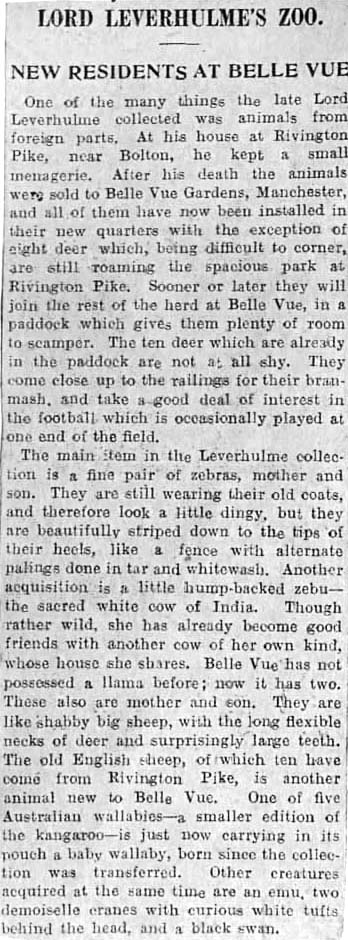 Even before John Jennison took possession of the land beside Kirkmanshulme Lane, he was involved in the display of animals for the interest of the public. Working as a jobbing gardener, he supplemented his income by opening the garden of his modest house in Adswood, south of Stockport town centre. In the beginning it was the garden itself that was the attraction, with Jennison's strawberries being a particular favourite with visitors. In time though he added a variety of caged birds for his Sunday guests to view. In fact, it was the success of the Adswood venture and the growing size of Jennison's menagerie that led to the move to Belle Vue. In May of 1837 Jennison placed an advertisement in the Guardian indicating the Belle Vue Gardens were open and that among the attractions was a large number of very beautiful birds and various animals. It is likely that the animals in question were rabbits, dogs, goats, and perhaps a fox. By 1847 there was a handbook for what was now referred to as the Zoological Gardens, Belle Vue. The collection by this time included silver fox, Australian dingo, raccoons, Brahmin bull, deer, Egyptian and Australian sheep, Armenian monkeys, rhesus monkey, wild cats, armadillos, coatimundi, and a bear, as well as Jennison's growing collection of domestic and exotic birds. These creatures were housed in a growing number of cages, paddocks, and aviaries, as well as on the various ponds. Even at this early stage though, Belle Vue was not just a zoo with a few other attractions. John Jennison was developing a multifaceted entertainment centre appealing to a wide audience. He offered dancing, flower shows, horse racing, circus, boating and a variety of refreshments. Belle Vue was a day out and the zoo was an important part of it, but from the beginning it competed for space and attention with all of the other ventures. The 1850's advertisement announced the new monkey house with its central cage that was 21 feet high and covered 600 square feet. By 1851 the growing collection of animals now included leopards, jaguars, yaks, porcupines, and kangaroos. It was during this period that a group of cages with a central walkway for visitors became the Paddock, a building which also survived for well over 100 years. The Paddock was home to ungulates like llamas, alpacas, zebu, zebra, and deer. 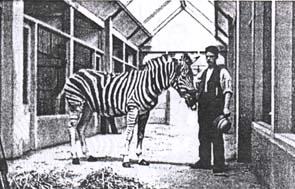 The bear pit was constructed beside the firework lake. It had an elevated platform which was at eye level for spectators. The pit housed three Russian brown bears. A cage with a pool was later added to house polar bears. 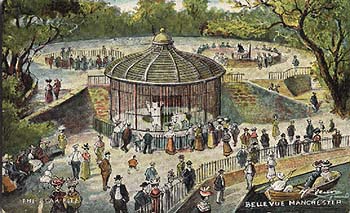 A pelican, a lioness, an ostrich, three mandrills, and a pair of Chinese lovebirds were purchased at this time. The first elephant appears to have been purchased in 1861 for £270, but it only lived for a short time. A large aviary was completed in 1866. It also housed lions. The first giraffe arrived in 1871. In 1872 a sale by auction occurred in Edinburgh to dispose of the animals from one of Wombwell's Traveling Menageries. Wombwell had three menageries that operated quite separately and were simply known as Number One, Number Two and Number Three. The original menagerie was, in fact, known as Wombwell's Royal Number One Menagerie, and in April of 1872 it was up for sale in the New Vegetable Market within the Waverley Market, Edinburgh. Among the assembled crowd was John Jennison's son James, and he made an historic purchase. James paid a total of £799 and acquired a baboon, a variety of antelope called a nylghau, a lioness called Victoria who was in cub to the famous lion Hannibal, and an 8 year old Indian Elephant called Maharajah. Even before Maharajah arrived at Belle Vue, he was the centre of media attention. When attempts to load him in a railway goods wagon resulted in the destruction of the wagon, the decision was made to walk him to Manchester. The journey of 10 days was made in the company of his keeper Lorenzo Lawrence. Along the way it was reported that there was an incident when Maharajah is reported to have removed a toll gate during an argument over a toll charge. The arrival at Bell Vue was arranged so that the pair entered the park on a busy Saturday to much fanfare. In 1877 a glass roofed Elephant House was built to house Maharajah and the female Sally who had been acquired in the intervening years. Nearby a glass Giraffe House was built. In 1881 the Monkey House, that I remember, opened. It was a large building designed to look like an Indian Temple, and once again there was a large central cage and a number of cages along the outside walls. The building used hot water heating to maintain a constant 60°F - 70°F temperature. 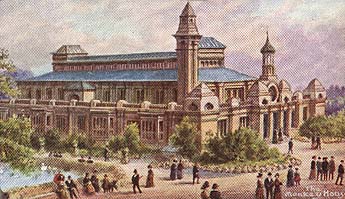 Nearby a large Camel and Dromedary House was built. Four years later a Seal House was added next door to the Camel House. In later years this was converted to house a performing sea-lion show. In 1893 James was once
again purchasing animals from the dispersal of another
of the Wombwell menageries. This time the prize was a
chimpanzee by the name of Consul. Consul in some ways
typified the Jennison approach to zoo keeping which was
quite appropriate in its day. The zoo was an attraction,
not a conservation, research, or breeding facility.
Consul captured the attention of the public by being
seen around the zoo in human clothing, smoking a pipe
and riding a tricycle and even playing a violin.
As we reach the end of the 19th century, Belle Vue's collection of animals was quite extensive and varied. The owners were also starting to learn something about how to keep their collection alive. Steps were taken to moderate the temperatures within animal houses, which cut the number of deaths from respiratory diseases. More animals were moved to outdoor enclosures. 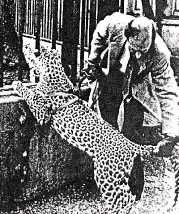 After the Jennison family relinquished control of Belle Vue in 1925, there was something of a change in the way that the zoo operated. Under the control of Gerald Iles, the zoo continued to be an attraction, but there was real evidence that now the welfare of the animals was much more of a priority. Some of the old houses were improved or replaced. However, overall the zoo continued to struggle because competing interests and, at times, financial constraints hampered Iles's plans. An outdoor enclosure known as the "Rocky Mountain Enclosure" was built beside the Paddock in 1928, before Iles was hired. 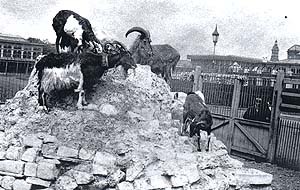 Then following his
appointment in 1933, the Elephant House was modified and
a small aquarium was added to the Reptile House.
Following the trend, and the fashion, towards outdoor
enclosures, a large steel gibbon cage was added, along
with a Monkey Mountain and a Raccoon Pit. The aquarium
was also expended. A new enclosure for rhinos was built
during this period, constructed using stone from the
demolished City Gaol that had been located on Belle
Vue's north-western edge. Below is an excerpt from
the 1947 Belle Vue Zoo Guide
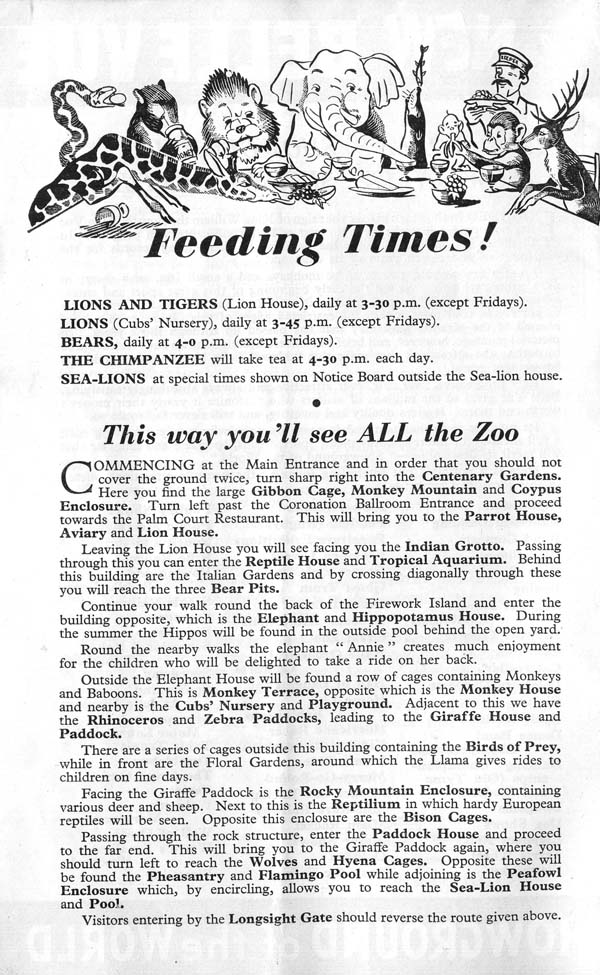 In 1955 Belle Vue opened a Children's Zoo next to the old fireworks factory. This was one of Gerald Ile's ideas and it cost £15,000 to build. The Children's zoo featured a system of streams and pools and as its centerpiece it had Willie the Whale. Built of concrete this 32 feet long and 8 feet high whale contained a small aquarium.
In 1957 a controversial open-air enclosure for monkeys was opened to replace the former Monkey Mountain that had to be demolished to make way for the Water Chute ride. It was a pit containing a concrete version of the "Giants' Causeway" , a series of hexagonal concrete columns of various heights. Located strategically to attract zoo visitors into the adjacent amusement park, it was widely criticized for its stark concrete surface within the noise and lights of the amusement park, but ironically the monkeys thrived in the enclosure. In the 1960s a marsupial enclosure was built near the Firework Island, a small Mammal House was created from the old Penguin House, and in 1963 the new Great Ape House opened, close to the Longsight Entrance. When the miniature railway was moved again, this time to run around the Fireworks Lake, several new animal enclosures were created for train riders to view. New lion enclosures were built along with what was known as "Wolf Wood". It was in the 1970s that new Bear Terraces were added in the vicinity of the Fireworks Lake. They shared a castellated wall with the adjacent firework display area. 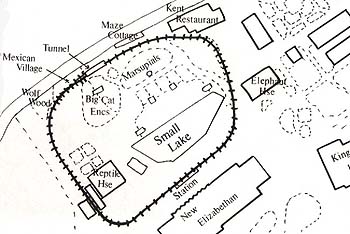 By the 1970s, as you can read in Phil Blinkhorn's commentary elsewhere on this site, the wheels were well and truly falling off the Belle Vue wagon. The first victim in the collapse of John Jennison's empire was the zoo. Despite the changes of the 40s, 50s, and 60s, many of the animals were housed in facilities that owed more to the 19th century than the 20th. With Chester Zoo on their doorstep, animal collections held in cramped conditions, behind bars and fences, were no longer PC. Whether it was true or not, Belle Vue's animal collection was seen to be unhealthy and neglected, and the Mike Harding stories of mangy lions was a generally held view. A zoo, surrounded by a rowdy amusement park and firework displays, no longer matched public opinions on animal welfare. The sale of the collection was a heartbreaking experience for those who had been charged with the care of the animals under impossible conditions. Most of the animals were placed elsewhere, but there were some tragic stories. Perhaps the most sad being the fate of the elephant "Ellie May" who had to be shot when pneumonia and heart-failure set in when, in a Maharajah-like gesture, she sat down refusing to be loaded on her transporter. The zoo closed for the last time on September 11, 1977. All the material on this web site is İ David Boardman, unless otherwise stated, and may not be copied, downloaded or otherwise reproduced or retransmitted without the written permission of the webmaster. Any contravention of the copyright of others is unintentional and will be corrected immediately when brought to the attention of the webmaster. |
